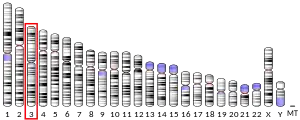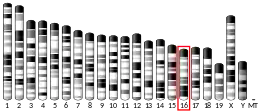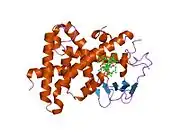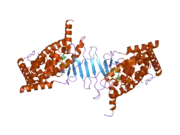Pregnane X receptor
In the field of molecular biology, the pregnane X receptor (PXR), also known as the steroid and xenobiotic sensing nuclear receptor (SXR) or nuclear receptor subfamily 1, group I, member 2 (NR1I2) is a protein that in humans is encoded by the NR1I2 (nuclear Receptor subfamily 1, group I, member 2) gene.[5][6][7]
Function
PXR is a nuclear receptor whose primary function is to sense the presence of foreign toxic substances and in response up regulate the expression of proteins involved in the detoxification and clearance of these substances from the body.[8] PXR belongs to the nuclear receptor superfamily, members of which are transcription factors characterized by a ligand-binding domain and a DNA-binding domain. PXR is a transcriptional regulator of the cytochrome P450 gene CYP3A4, binding to the response element of the CYP3A4 promoter as a heterodimer with the 9-cis retinoic acid receptor RXR. It is activated by a range of compounds that induce CYP3A4, including dexamethasone and rifampicin.[7][9]
Ligands
Agonists
PXR is activated by a large number of endogenous and exogenous chemicals[8] including steroids (e.g., progesterone, 17α-hydroxyprogesterone, 17α-hydroxypregnenolone, 5α-dihydroprogesterone, 5β-dihydroprogesterone, allopregnanolone, corticosterone, cyproterone acetate, spironolactone, dexamethasone, mifepristone), antibiotics (e.g., rifampicin, rifaximin), antimycotics, bile acids, hyperforin (a constituent of St. John's Wort), and other compounds such as meclizine, paclitaxel, cafestol,[10] and forskolin.[11][12]
Antagonists
Ketoconazole is an example of one of the relatively few-known antagonists of the PXR.[13][14] SPA70 (also known as LC-1) was recently identified and characterized as a potent and selective PXR antagonist.[15][16]
Mechanism
Like other type II nuclear receptors, when activated, it forms a heterodimer with the retinoid X receptor, and binds to hormone response elements on DNA which elicits expression of gene products.[8]
One of the primary targets of PXR activation is the induction of CYP3A4, an important phase I oxidative enzyme that is responsible for the metabolism of many drugs.[6][7] In addition, PXR up regulates the expression of phase II conjugating enzymes such as glutathione S-transferase[17] and phase III transport uptake and efflux proteins such as OATP2[18] and MDR1.[19][20]
References
- GRCh38: Ensembl release 89: ENSG00000144852 - Ensembl, May 2017
- GRCm38: Ensembl release 89: ENSMUSG00000022809 - Ensembl, May 2017
- "Human PubMed Reference:". National Center for Biotechnology Information, U.S. National Library of Medicine.
- "Mouse PubMed Reference:". National Center for Biotechnology Information, U.S. National Library of Medicine.
- Entrez result for NR1I2.
- Lehmann JM, McKee DD, Watson MA, Willson TM, Moore JT, Kliewer SA (September 1998). "The human orphan nuclear receptor PXR is activated by compounds that regulate CYP3A4 gene expression and cause drug interactions". The Journal of Clinical Investigation. 102 (5): 1016–23. doi:10.1172/JCI3703. PMC 508967. PMID 9727070.
- Bertilsson G, Heidrich J, Svensson K, Asman M, Jendeberg L, Sydow-Bäckman M, Ohlsson R, Postlind H, Blomquist P, Berkenstam A (October 1998). "Identification of a human nuclear receptor defines a new signaling pathway for CYP3A induction". Proceedings of the National Academy of Sciences of the United States of America. 95 (21): 12208–13. Bibcode:1998PNAS...9512208B. doi:10.1073/pnas.95.21.12208. PMC 22810. PMID 9770465.
- Kliewer SA, Goodwin B, Willson TM (October 2002). "The nuclear pregnane X receptor: a key regulator of xenobiotic metabolism". Endocrine Reviews. 23 (5): 687–702. doi:10.1210/er.2001-0038. PMID 12372848.
- "Entrez Gene: NR1I2 nuclear receptor subfamily 1, group I, member 2".
- Ricketts ML, Boekschoten MV, Kreeft AJ, Hooiveld GJ, Moen CJ, Müller M, Frants RR, Kasanmoentalib S, Post SM, Princen HM, Porter JG, Katan MB, Hofker MH, Moore DD (July 2007). "The cholesterol-raising factor from coffee beans, cafestol, as an agonist ligand for the farnesoid and pregnane X receptors". Molecular Endocrinology. 21 (7): 1603–16. doi:10.1210/me.2007-0133. PMID 17456796.
- Kaur J, Sodhi RK, Madan J, Chahal SK, Kumar R (February 2018). "Forskolin convalesces memory in high fat diet-induced dementia in wistar rats-Plausible role of pregnane x receptors". Pharmacological Reports. 70 (1): 161–171. doi:10.1016/j.pharep.2017.07.009. PMID 29367103. S2CID 3872389.
- Ding, X. (2004). "Induction of Drug Metabolism by Forskolin: The Role of the Pregnane X Receptor and the Protein Kinase A Signal Transduction Pathway". Journal of Pharmacology and Experimental Therapeutics. 312 (2): 849–856. doi:10.1124/jpet.104.076331. ISSN 0022-3565. PMID 15459237. S2CID 8056821.
- Li H, Dou W, Padikkala E, Mani S (November 2013). "Reverse yeast two-hybrid system to identify mammalian nuclear receptor residues that interact with ligands and/or antagonists". Journal of Visualized Experiments (81): e51085. doi:10.3791/51085. PMC 3904218. PMID 24300333.
- Mani S, Dou W, Redinbo MR (February 2013). "PXR antagonists and implication in drug metabolism". Drug Metabolism Reviews. 45 (1): 60–72. doi:10.3109/03602532.2012.746363. PMC 3583015. PMID 23330542.
- Lin W, Goktug AN, Wu J, Currier DG, Chen T (December 2017). "High-Throughput Screening Identifies 1,4,5-Substituted 1,2,3-Triazole Analogs as Potent and Specific Antagonists of Pregnane X Receptor". Assay and Drug Development Technologies. 15 (8): 383–394. doi:10.1089/adt.2017.809. PMC 5731549. PMID 29112465.
- Lin W, Wang YM, Chai SC, Lv L, Zheng J, Wu J, Zhang Q, Wang YD, Griffin PR, Chen T (September 2017). "SPA70 is a potent antagonist of human pregnane X receptor". Nature Communications. 8 (1): 741. Bibcode:2017NatCo...8..741L. doi:10.1038/s41467-017-00780-5. PMC 5622171. PMID 28963450.
- Falkner KC, Pinaire JA, Xiao GH, Geoghegan TE, Prough RA (September 2001). "Regulation of the rat glutathione S-transferase A2 gene by glucocorticoids: involvement of both the glucocorticoid and pregnane X receptors". Molecular Pharmacology. 60 (3): 611–9. PMID 11502894.
- Staudinger JL, Goodwin B, Jones SA, Hawkins-Brown D, MacKenzie KI, LaTour A, Liu Y, Klaassen CD, Brown KK, Reinhard J, Willson TM, Koller BH, Kliewer SA (March 2001). "The nuclear receptor PXR is a lithocholic acid sensor that protects against liver toxicity". Proceedings of the National Academy of Sciences of the United States of America. 98 (6): 3369–74. Bibcode:2001PNAS...98.3369S. doi:10.1073/pnas.051551698. PMC 30660. PMID 11248085.
- Synold TW, Dussault I, Forman BM (May 2001). "The orphan nuclear receptor SXR coordinately regulates drug metabolism and efflux". Nature Medicine. 7 (5): 584–90. doi:10.1038/87912. PMID 11329060. S2CID 34155288.
- Geick A, Eichelbaum M, Burk O (May 2001). "Nuclear receptor response elements mediate induction of intestinal MDR1 by rifampin". The Journal of Biological Chemistry. 276 (18): 14581–7. doi:10.1074/jbc.M010173200. PMID 11297522.
Further reading
- Watkins RE, Noble SM, Redinbo MR (January 2002). "Structural insights into the promiscuity and function of the human pregnane X receptor". Current Opinion in Drug Discovery & Development. 5 (1): 150–8. PMID 11865669.
- Maruyama K, Sugano S (January 1994). "Oligo-capping: a simple method to replace the cap structure of eukaryotic mRNAs with oligoribonucleotides". Gene. 138 (1–2): 171–4. doi:10.1016/0378-1119(94)90802-8. PMID 8125298.
- Suzuki Y, Yoshitomo-Nakagawa K, Maruyama K, Suyama A, Sugano S (October 1997). "Construction and characterization of a full length-enriched and a 5'-end-enriched cDNA library". Gene. 200 (1–2): 149–56. doi:10.1016/S0378-1119(97)00411-3. PMID 9373149.
- Kliewer SA, Moore JT, Wade L, Staudinger JL, Watson MA, Jones SA, McKee DD, Oliver BB, Willson TM, Zetterström RH, Perlmann T, Lehmann JM (January 1998). "An orphan nuclear receptor activated by pregnanes defines a novel steroid signaling pathway". Cell. 92 (1): 73–82. doi:10.1016/S0092-8674(00)80900-9. PMID 9489701. S2CID 16954668.
- Lehmann JM, McKee DD, Watson MA, Willson TM, Moore JT, Kliewer SA (September 1998). "The human orphan nuclear receptor PXR is activated by compounds that regulate CYP3A4 gene expression and cause drug interactions". The Journal of Clinical Investigation. 102 (5): 1016–23. doi:10.1172/JCI3703. PMC 508967. PMID 9727070.
- Bertilsson G, Heidrich J, Svensson K, Asman M, Jendeberg L, Sydow-Bäckman M, Ohlsson R, Postlind H, Blomquist P, Berkenstam A (October 1998). "Identification of a human nuclear receptor defines a new signaling pathway for CYP3A induction". Proceedings of the National Academy of Sciences of the United States of America. 95 (21): 12208–13. Bibcode:1998PNAS...9512208B. doi:10.1073/pnas.95.21.12208. PMC 22810. PMID 9770465.
- Blumberg B, Sabbagh W, Juguilon H, Bolado J, van Meter CM, Ong ES, Evans RM (October 1998). "SXR, a novel steroid and xenobiotic-sensing nuclear receptor". Genes & Development. 12 (20): 3195–205. doi:10.1101/gad.12.20.3195. PMC 317212. PMID 9784494.
- Dotzlaw H, Leygue E, Watson P, Murphy LC (August 1999). "The human orphan receptor PXR messenger RNA is expressed in both normal and neoplastic breast tissue". Clinical Cancer Research. 5 (8): 2103–7. PMID 10473093.
- Geick A, Eichelbaum M, Burk O (May 2001). "Nuclear receptor response elements mediate induction of intestinal MDR1 by rifampin". The Journal of Biological Chemistry. 276 (18): 14581–7. doi:10.1074/jbc.M010173200. PMID 11297522.
- Watkins RE, Wisely GB, Moore LB, Collins JL, Lambert MH, Williams SP, Willson TM, Kliewer SA, Redinbo MR (June 2001). "The human nuclear xenobiotic receptor PXR: structural determinants of directed promiscuity". Science. 292 (5525): 2329–33. doi:10.1126/science.1060762. PMID 11408620. S2CID 20871563.
- Zhang J, Kuehl P, Green ED, Touchman JW, Watkins PB, Daly A, Hall SD, Maurel P, Relling M, Brimer C, Yasuda K, Wrighton SA, Hancock M, Kim RB, Strom S, Thummel K, Russell CG, Hudson JR, Schuetz EG, Boguski MS (October 2001). "The human pregnane X receptor: genomic structure and identification and functional characterization of natural allelic variants". Pharmacogenetics. 11 (7): 555–72. doi:10.1097/00008571-200110000-00003. PMID 11668216.
- Gonzalez MM, Carlberg C (May 2002). "Cross-repression, a functional consequence of the physical interaction of non-liganded nuclear receptors and POU domain transcription factors". The Journal of Biological Chemistry. 277 (21): 18501–9. doi:10.1074/jbc.M200205200. PMID 11891224.
- Takeshita A, Taguchi M, Koibuchi N, Ozawa Y (September 2002). "Putative role of the orphan nuclear receptor SXR (steroid and xenobiotic receptor) in the mechanism of CYP3A4 inhibition by xenobiotics". The Journal of Biological Chemistry. 277 (36): 32453–8. doi:10.1074/jbc.M111245200. PMID 12072427.
- Frungieri MB, Weidinger S, Meineke V, Köhn FM, Mayerhofer A (November 2002). "Proliferative action of mast-cell tryptase is mediated by PAR2, COX2, prostaglandins, and PPARgamma : Possible relevance to human fibrotic disorders". Proceedings of the National Academy of Sciences of the United States of America. 99 (23): 15072–7. Bibcode:2002PNAS...9915072F. doi:10.1073/pnas.232422999. PMC 137545. PMID 12397176.
- Fukuen S, Fukuda T, Matsuda H, Sumida A, Yamamoto I, Inaba T, Azuma J (November 2002). "Identification of the novel splicing variants for the hPXR in human livers". Biochemical and Biophysical Research Communications. 298 (3): 433–8. doi:10.1016/S0006-291X(02)02469-5. PMID 12413960.
- Chang TK, Bandiera SM, Chen J (January 2003). "Constitutive androstane receptor and pregnane X receptor gene expression in human liver: interindividual variability and correlation with CYP2B6 mRNA levels". Drug Metabolism and Disposition. 31 (1): 7–10. doi:10.1124/dmd.31.1.7. PMID 12485946. S2CID 42133087.
- Dussault I, Yoo HD, Lin M, Wang E, Fan M, Batta AK, Salen G, Erickson SK, Forman BM (February 2003). "Identification of an endogenous ligand that activates pregnane X receptor-mediated sterol clearance". Proceedings of the National Academy of Sciences of the United States of America. 100 (3): 833–8. Bibcode:2003PNAS..100..833D. doi:10.1073/pnas.0336235100. PMC 298687. PMID 12569201.
- Kawana K, Ikuta T, Kobayashi Y, Gotoh O, Takeda K, Kawajiri K (March 2003). "Molecular mechanism of nuclear translocation of an orphan nuclear receptor, SXR". Molecular Pharmacology. 63 (3): 524–31. doi:10.1124/mol.63.3.524. PMID 12606758. S2CID 6402235.
External links
- pregnane+X+receptor at the U.S. National Library of Medicine Medical Subject Headings (MeSH)
- Nuclear Receptor Resource Page
This article incorporates text from the United States National Library of Medicine, which is in the public domain.












